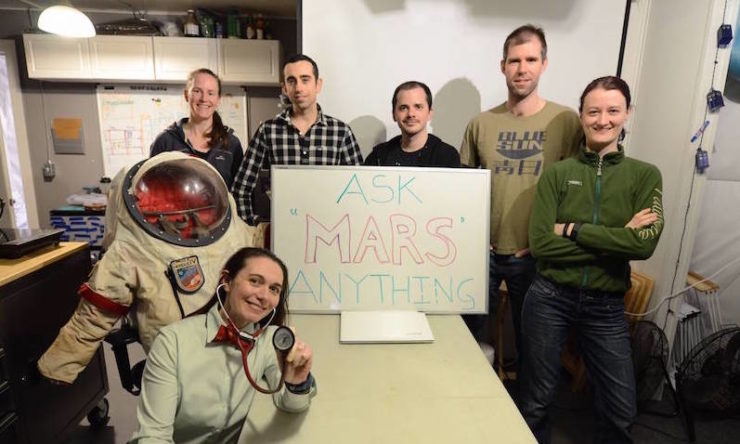On August 28, six NASA crew members successfully wrapped up the fourth HI-SEAS mission by “returning” to Earth from Mars. Here’s the thing: They never actually left the planet.
The HI-SEAS (Hawaii Space Exploration Analog and Simulation) missions simulate life on Mars by having a crew live in a small dome about 8,000 feet above sea level, on the slopes of Hawaii’s Mauna Loa volcano—the closest approximation to the surface and conditions of the Red Planet. Isolated from Earth, with limited resources and not much space, the crew are guinea pigs for the effects of isolation and confined quarters on future Mars trips. The fourth HI-SEAS mission was the longest yet, with the crew locked away for a full year.
To be honest, I find myself more fascinated by these kinds of stories than by how Mark Watney survives in The Martian—not that the stakes aren’t terribly high in that case, but also for this reason: The HI-SEAS crew were not misled about where they are; there was always a “safety net” in place if anything truly disastrous had happened. Take this quote from a video recorded halfway through the mission: “On Mars, we would know that we are part of history,” crew biologist Cyprien Verseux says, “whereas here… well, we’re lucky if we have a footnote in a history book.” I would respectfully disagree, considering all of the attention this mission has gotten. If anything, knowing that they were on Earth and training themselves to act as if they’re on another planet must have made for a really fascinating mental (and, by extension, emotional) state.
Of course, the setup of HI-SEAS was meant to help with that: Supplies were replenished only every few months (food every four months, water every two); their transmissions to Earth were on a 20-minute delay (not quite Interstellar, but still creating a sense of detachment); and if they wanted to go outside, they could do so only wearing heavy, puffy spacesuits.
There were also the group dynamics to navigate. While each crew member had one or more distinct jobs—commander, physicist, biologist, doctor, engineer, architect, journalist—to perform, some of their greatest challenges included learning how to coexist in a tiny shared space without going insane, fighting off the effects of loneliness, and dealing with everything from a pesky wart removal to an unplanned communications blackout. (The crew did a Reddit AMA in June discussing how they defused interpersonal conflict and how much more productive they were without the distractions of viral YouTube videos.)
For a crew practicing isolation on Mars, there’s plenty of information online about this HI-SEAS mission—and we’ll know a lot more once NASA has a chance to analyze the data from the first four missions. In the meantime, filmmakers Lauren DeFelippo and Katherine Gorringe are crowdfunding Red Heaven, a documentary about the crew’s year in isolation. Upon meeting the six HI-SEAS crew members before they entered the dome last August, DeFelippo and Gorringe shot some preliminary interviews, then left the six with handheld cameras to record their daily activities in the hopes of providing “a raw and intimate look into what life on Mars might really be like.”
In addition to the official HI-SEAS website, crew journalist Sheyna E. Gifford also posted updates on the blog Live From Mars, talking about the various challenges of surviving on “sMars.” I’ll leave you with this excerpt from her final blog post, reflecting on the year and a day spent away from Earth:
Technically, my crew never left the planet. Just as true: our species has only just arrived. To this day, in fact, we’re mostly not of this world. I don’t mean in the Carl Sagan, we-are-stardust way, though that’s true too. I mean that each and every one of us is mostly water. Most of the water on this Earth has been measured and proven to be from comets. So you were brought here, really, bit by bit, molecule by molecule, assembled and constructed over eons. Maybe that’s why we’re always trying to leave here: The journey was never mean to be one-way. Or maybe the joy and terror of riding through the skies was captured along with those bits of ice and rock. Maybe the will to wander through the stars still resonates in the bonds that hold one hydrogen to another. I couldn’t say for sure. I am a just traveler myself. I came here with a leather bag. Tools were taken out. Tools were used, and returned.










